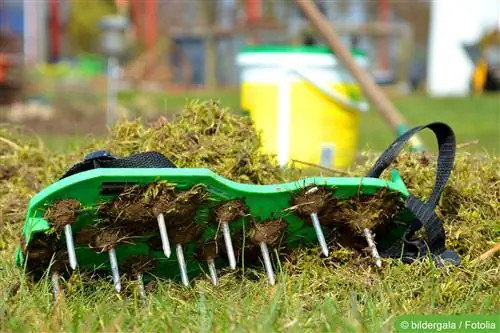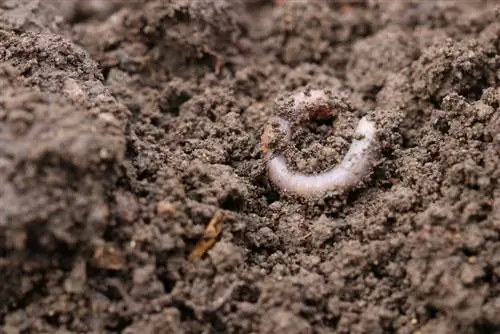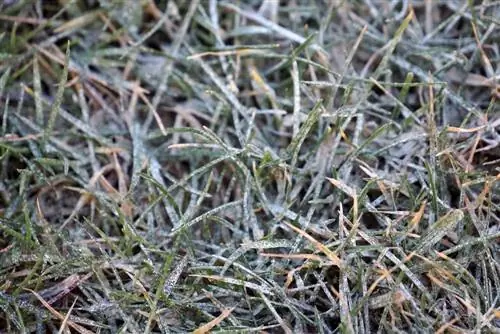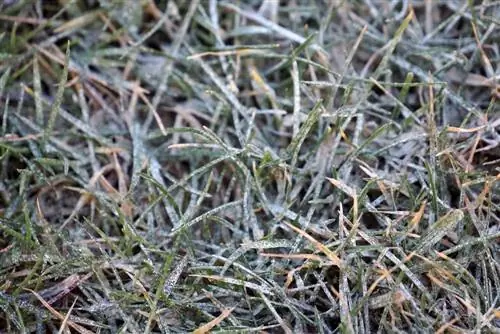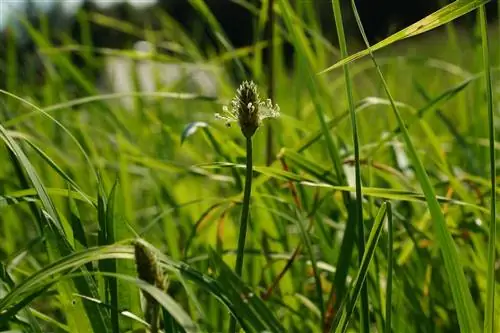- Author admin [email protected].
- Public 2023-12-17 03:39.
- Last modified 2025-06-01 06:48.
Every spring the garden owner is faced with the question of whether scarifying alone is doing the best thing for the lawn. This is often not enough because scarifying only aerates the surface of the lawn and does not go deep. However, the problems often lie deeper, where the roots of weeds develop under the moss. This is where it is important to start in order to ensure he althy root growth in the lawn. Aeration is the right method for this. Here we will explain to you how it works and how you can best cultivate your lawn.
Interesting facts and basics
After the long winter months, the lawn in the garden is often not a pretty sight. Moss has taken hold; Weeds, especially dandelions, spread between lawn plants and scarifying doesn't really help. Now it is important to aerate the lawn with the soil underneath. Golf courses and soccer turfs that are professionally maintained have long benefited from the ground being aerated. The soil is loosened and aerated to its depth so that air, water and nutrients reach the roots more easily. The resulting holes can then be filled with sand to create sustainable drainage, and reseeding should only be carried out now.
Weed infestation of the lawn can also occur to an increased extent through the use of chemical-based weed killers. These products stress the lawn roots and no longer develop enough strength to resist the establishment of stubborn weeds and moss. So through chemical products you achieve exactly the opposite of what you actually want. Aerating strengthens the soil structure, strengthens the lawn roots and ultimately makes the use of weed killers unnecessary.
The principle has been known since 1946, while the very popular scarifying was only developed and brought onto the market later in 1955 by the same inventor. Although there are two different methods of aeration, the basics of both are the same. Holes are pierced deep into the ground with long thorns, so-called spoons, which stimulate the activity of soil organisms, facilitate water drainage and provide air for the roots to grow. These holes are then filled.
- combine aerating and scarifying to give the lawn plenty of air
- carry out this work in mid to early May, before the growing season really begins
- In stubborn cases, the lawn can be aerated again in autumn
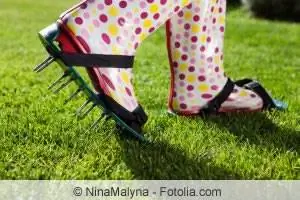
Aeration with hollow spoons
Aerating with hollow thorns is a method preferred by professionals. The spoons are inserted into the ground about 7 cm deep. The ground pushes up through the tubes and is caught in a container, so that the spoon does not have to be laboriously cleaned with every stroke. The spines have a diameter of 2 to 2.5 cm, the distance between two spines is around 15 cm. This ensures that the holes are not made too close together, which could in turn cause damage to the lawn. This type of aerator is offered by different manufacturers, each with a different number of spoons. The principle remains the same, but some of the devices have several spoons next to each other, which can sometimes require a lot of physical strength when used manually. It makes sense and is easy to use 2 to 3 spoons that can be inserted into the ground without excessive force. For each piercing, the device is lifted and re-inserted into the ground. Due to the physical effort, this method is only worthwhile for smaller areas, but larger areas of lawn can be worked on with an electrically powered device. These can also be rented from many specialist retailers.
The holes created in this way are filled with coarse sand after aeration, which supports the water flow as permanent drainage and allows significantly more air to reach the lawn roots. This measure also prevents waterlogging from developing in the subsoil due to excessive soil compaction.
Tip:
To make your work easier, the sand to be filled can be mixed with lawn fertilizer and seeds. This also prevents birds from picking up the grass seed as welcome food.
Aerating with the aerator and fixed spoons
An aerator with solid spikes works in the same way as the devices with hollow spikes. Here, however, the spoons are often attached to a rotating wheel that rotates as a result of the movement, so that the device does not have to be lifted and inserted again for each work step. This method does not excavate soil through the hollow tube; instead, the soil is displaced and compacted, which is why some professionals prefer the other method. But here too, a hole is pierced deep into the ground, which stimulates the activity of the soil organisms, supplies the roots with air and enables the lawn roots to better absorb nutrients. The Aerator does not require as much effort, which is why it is ideal for small gardens with correspondingly small lawns.
Fill the resulting holes with sand here too, dense roots prevent the soil from drying out
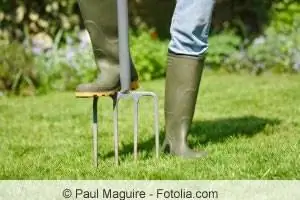
Additional advice
- For a small garden, cultivation with a digging fork, which is inserted into the ground at regular intervals, is often sufficient
- aerating can be very time-consuming for larger areas, so you should consider purchasing or renting an electrical device
- Be sure to stick to the aeration season, later processing can damage the grass base
Conclusion of the editors
If you want a really beautiful, strong lawn with lush greenery and strong growth, you should definitely aerate. This is sustainable soil aeration that significantly improves the lawn and the soil structure. It doesn't matter whether the lawn is large or small, because only he althy soil with strong lawn roots is able to assert itself against moss and weeds. When you aerate, you do the best for the lawn, which also benefits the rest of the garden.
Things worth knowing about aerfication coming soon
- An aerator promotes gas exchange in the soil.
- Long, pointed hollow spines penetrate the ground and ensure that ventilation and the drainage of rainwater are possible again.
- The best time to aerate your lawn is from May to September, as the lawn development is in full swing here.
- Depending on the demand on the lawn, it is worth aerating it once a month during this time to ensure optimal growth.
- When selecting the aerator, spikes should be used that reach a depth of up to 8 cm and pierce 350 holes per square meter.
Suitable aerators
There is a large selection of aerators of very different types. The best are undoubtedly the professional devices, such as those used on golf courses. But these are expensive, really expensive. If you want to aerate enough of your lawn to make such a device worthwhile, you should first find out whether there is one available to rent nearby. If that's not the case, try it at www.goettingen.mieten.gartentechnik.com/gartentechnik/aerifizierer/. Buying such an expensive aerator is rarely worth it; renting it is much better.
- The cheapest solution is definitely lawn aerator shoes, simply nail shoes that can be strapped to any shoe. The tines are 10 to 13 cm long. The shoes cost around 10 euros.
- Lawn aerator with blades that can be used on both sides. Working width just under 40 cm, one side blades about 10 cm long, other side 20 cm. Fan without handle about 12 euros.
- Aerating fork - to be used like a spade, you pierce the lawn. Has three or four prongs. Costs around 50 euros. Although there are cheaper devices, they usually don't last long. You can also use digging or pitchforks.
- Aerating fork with hollow tines - has the advantage that approximately 10 mm wide holes are punched out of the lawn. These can be filled with sand. Due forks are also available from around 50 euros. The work is laborious and hardly suitable for larger lawns.
- Hand-held Verti-Drain 060 - working width 60 cm, hole spacing 4 x 4 cm, working depth 15 cm, for small and less resilient areas, approx. 65 euros, can be used with both solid and hollow spoons
- Electric devices that have two functions, scarifying and aerating, are cheap. They have a scarifying roller and a fan roller. Various models are available starting from around 100 euros. There are also significantly more expensive ones.
Tips for aerating
- The hole density is crucial for the quality of the work. That's why professional devices are simply the better choice.
- A hole density of 400 to 500 holes per m² is ideal. 200 to 250 are sufficient, below that it often doesn't do much.
- The penetration depth of the hollow spines should be at least 5 cm. Slitting is often a good complement to aerating.
- The spoons or spikes only displace the earth; hollow spikes, which dig up the earth and move it outwards, are more effective.
- This allows a lot of air to reach the grass roots. The metabolism is optimized and the growth of the grass is increased.
- Aerating is carried out after scarifying. Spring, at the beginning of the growing season, is particularly suitable.
- A scarifier only cuts the lawn and removes dead grass and plant parts.
- Deep-lying problems can only be resolved through aeration. The deeper the soil is tilled, the better it is for him.

